|
|
Advertisement:
|
|
T-Force Cardea Zero Z330 NVMe SSD |
|
Join the community - in the OCAU Forums!
|
Another SSD review today, and it's another from Team Group. This time it's a slightly surprising choice, the T-Force Cardea Zero Z330. Why surprising? Well, this is a PCIe Gen 3 drive, but PCIe Gen 4 drives are well established in the market. In fact I've already reviewed a PCIe Gen 4 drive from Team Group, their Cardea C440 Ceramic - and liked it. Gen 5 is available on the very latest Intel CPUs now as well. But if you have a legacy system that only supports Gen 3, I assume it doesn't make much sense to pay extra for a Gen4 drive - but we will test that assumption in this review. I should also confess that I wrote that introduction about three months ago but due to various factors this review has been delayed until now.
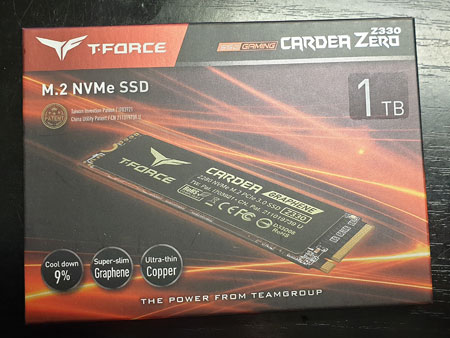
The other noteworthy difference between the earlier drive and this one is that the ceramic heat-spreader on the C440 has been replaced with a patented "graphene copper foil" unit on the Z330. To quote the spec page: The graphene copper foil and insulation layer are glued together by special stacking technology, and the thickness is less than 1mm. The ultra-thin M.2 PCIe SSD is exclusively built for gaming laptops/ high-performance PC with limited installation space. I thought the term "graphene copper foil" sounded familar and indeed it was also present on their DDR4 SODIMMs I reviewed back in 2019.
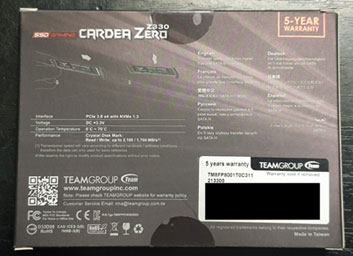 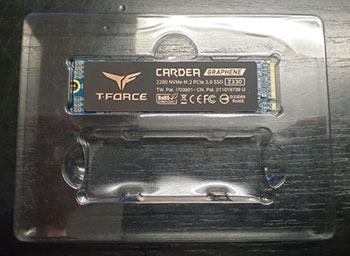
The box says "cool down 9%", although it doesn't say compared to what, but we should still expect this drive to run cooler than others. We'll see during testing. Speaking of the box, Team Group continue to minimise the inclusions in their package, and this one has literally only the drive itself in a plastic clamshell and a cardboard outer box. No case badge, no quick-start manual, no FCC compliance sheet, nothing. That's fair enough, in this internet-connected world. You can find installation instructions online easily enough.
 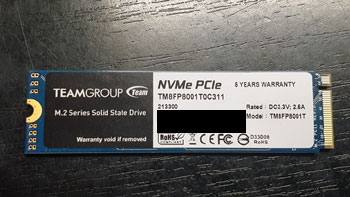
The drive is available with a blue or black PCB and in 512GB, 1TB and 2TB sizes. We have the 1TB blue one. The drive supports all modern SSD features including SMART, TRIM, Garbage Collection, LDPC ECC and E2E Data Protection, which both seem to be forms of on-drive error correction. Installation is simple enough and the drive formatted to 954GB.
I thought this might be an interesting opportunity to explore NVMe SSD performance in machines that support PCIe Gen 4, or only Gen 3. So, firstly let's test it on a machine that DOES support PCIe Gen 4, my current main machine, an AMD Ryzen 9 3900X on Gigabyte's X570 Gaming X motherboard with 4x8GB of Crucial Ballistix DDR4 3200MHz memory. We can compare it with the other two 1TB NVMe SSDs I have here, being the aforementioned Team Group C440 and the Crucial P1 I reviewed way back in 2018. Both these drives have been in use for a while, and the C440 is about half full, while the Z330 is fresh out of the box. All drives report 100% health in CrystalDiskInfo, but during the course of testing for this review, the C440 dropped to 99%.
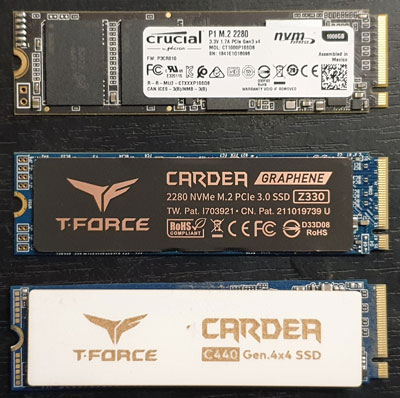
First up, CrystalDiskMark. Each set of tests was run twice to make sure the screenshot is representative:
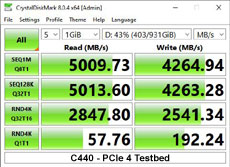 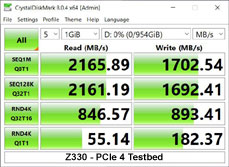 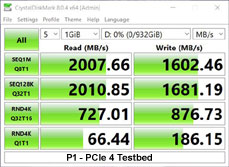
C440 - Z330 - P1
Not too surprisingly, the C440 takes advantage of its PCIe Gen 4 support and blitzes the other two drives. However when comparing the Gen 3 drives, there's not much in it. Considering I reviewed the P1 back in 2018, it's a bit disappointing that the Z330 doesn't more obviously beat it.
Next, a simple copy-to-self test. In this test I copy a given set of data from a directory to another directory on the same drive. I delete the copy and copy it again, timing it both times with the stopwatch function of the clock in Windows 10. An average of those two runs is recorded. The data set contains a range of large, medium and small files - a mix of installation directories, PDFs, documents and spreadsheets, thousands of images, large media files and zip archives. In total about 101GB in 15,941 files. This is enough to exhaust any caches and show us the real speed of the drive across a variety of workloads.
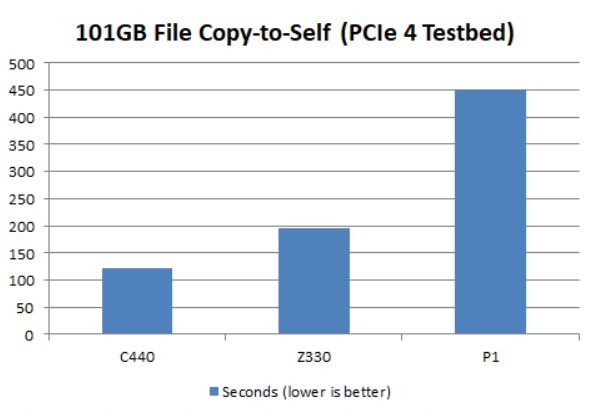
Again no surprises here, with the C440 being a clear winner, and this time the Z330 does clearly pull ahead of the older P1.
But what if your system doesn't support PCIe Gen 4? In many of my previous reviews I have pointed out the other advantages of M.2 drives, besides raw speed. They are a great way to upgrade older systems, even if you have to use a PCIe converter card as I do in my old Dell PowerEdge R610 server, and even my ancient original-generation HP MicroServer N36L. It's a pain to upgrade the storage in those machines by "official" means, but an NVMe drive in a PCIe card has transformed them and greatly extended their service life. But they definitely don't support PCIe Gen 4!
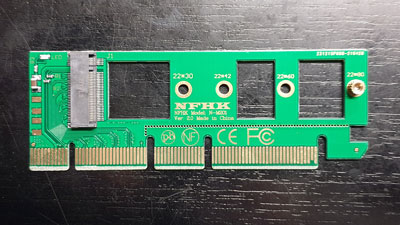
So let's try these three drives in my previous testbed, built around an Asus Z97-A with an i5-4690 CPU and, at the time of testing, only 8GB of PC3-8500 memory I'd borrowed from a server. The onboard M.2 slot on this motherboard actually only supports SATA M.2 drives, so all 3 drives were run in a PCIe card for NVMe support. I have a few of these cards now, all of the "random eBay" variety, but for consistency I picked the newest one, which has "NFHK Model N-M201 Ver. 2.0" silkscreened onto it.

You can see in CrystalDiskInfo that the C440 in this example reports "PCIe 3.0 x4 | PCIe 4.0 x4" which is indicating the drive's current mode (in this case limited by the motherboard) followed by its maximum supported mode.
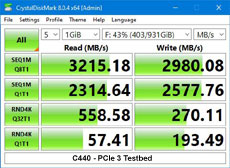 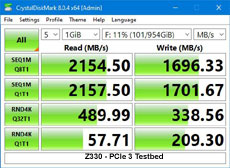 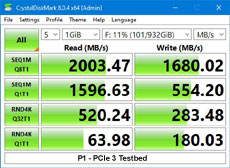
C440 - Z330 - P1
Anyway, we can see the C440 takes quite a speed hit here, thanks to being throttled by PCIe 3.0 - dropping from 5GB/s down to about 3.2GB/s in the first sequential read test. The other drives barely drop at all, which makes sense given they are not changing PCIe mode. I'm not sure what's going on with the first random write test on the P1 in this testbed, as it has dropped to about a third of what it got in the Ryzen machine, but is about the same for all other results. So, setting that one aside, the Z330 and P1 remain on pretty even terms.
On to the copy-to-self test, run as before:
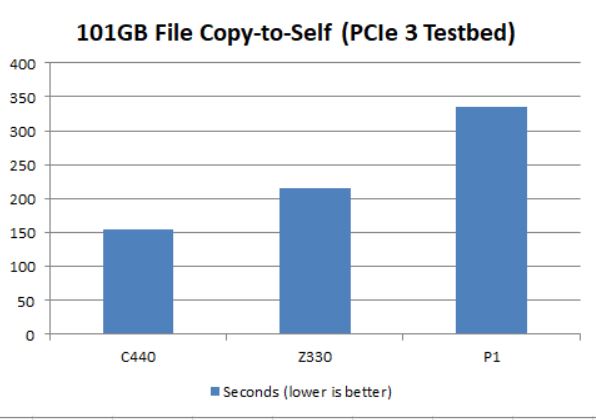
The C440 takes a little longer but still handily beats the others, even when hamstrung from its true performance by not being able to go into PCIe 4.0 mode. The Z330 once again beats the older P1 in this test but despite the level playing field of PCIe Gen 3, the Z330 is no match for its higher-performance C440 cousin from Team Group.
But there's also an interesting anomaly here, and it's noteworthy because it's the first time I've observed it. The P1 takes substantially less time in the file copy test on this i5 testbench than it did on the Ryzen machine. When I repeated the tests I realised why. I had noted a drop-off in performance towards the end of the file copy on the Ryzen machine but hadn't paid too much attention to it, thinking it was some peculiarity of the caching on the drive. But that drop-off did not appear on the i5 testbed. What's the difference? Temperature.
In the i5 machine we are using the onboard graphics of the CPU, so there is plenty of free air around the card in the M.2 adapter in the PCIe slot and not much heat being generated inside the case. Note there is another 512GB Samsung drive (the OS drive) in another PCIe M.2 card below the one used for testing:
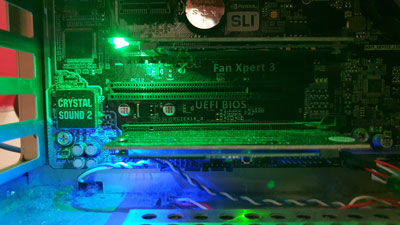
But in the Ryzen machine there is a GTX 1660 Super directly above the onboard M.2 slot. Normally this machine also has an RTX 3060 Ti in it and both cards are mining, so I habitually have two fans near the bottom of the case as that arrangement seems the best for keeping the temperatures down.
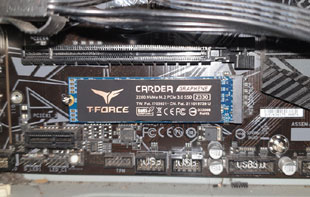 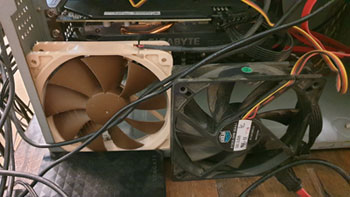
For this test the 3060 was removed and I was not mining but the fans were present, and even so, it seems like the P1 is hitting 64C and thermal throttling. In the i5 machine it only hits about 59C during the copy and does not noticeably slow down. It's pretty obvious when thermal throttling kicks in on the Ryzen machine:
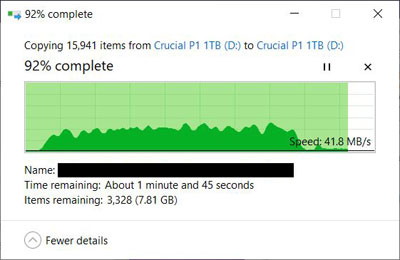
In the past I've been a bit dismissive of thermal throttling issues on M.2 drives, and again I think we had to go out of our way for it to have a bearing on the tests. You're talking about more than 5 minutes of sustained simultaneous reading AND writing before it became an issue. With the speed of these drives, even the slower ones, it's not too often you are going to be hammering the drive that hard for that long. But I have to note that I did not see any evidence of thermal throttling on the other two drives at any point. Is that because they have fancy ceramic (on the C440) or metal-foil (on the Z330) heat-spreaders? Well, I did see the C440 peak at 65C with no throttling, and the Z330 at one point reached a toasty 73C, but again no throttling. Meanwhile the P1 seemed to throttle at about 63-64C. So maybe the P1 is just more sensitive. All I can really draw from this is that the two Team Group drives do not seem to have any thermal issues, which is good to know, but I wouldn't say they exhibit any amazing heat-dissipating abilities even with their fancy heat-spreaders.
But what conclusions can we draw from the speed testing? I started this review by saying the Z330 was an odd choice to review at this stage. I guess the question we really need to ask is, why would you buy the Z330 instead of, say, the C440, also from Team Group? Even if you don't have access to PCIe 4.0, the C440 remained faster than the Z330 even when hamstrung to PCIe 3.0. Given they have the same warranty and the same overall features, surely the only remaining factor is price.
A quick look around shows the Z330 can be had for around $160 AUD. Update: Team Group mentioned a retail partner who have it for $130 AUD currently - that is not an affiliate link, btw. A quick look for the C440 shows.. that it has been discontinued. It was around double the price of the Z330 but that was a while ago and prices have moved on. So what else can we get for around $130 AUD on the 1TB NVMe side of things? Looking around the web, it's easy to find an array of 1TB PCIe 3.0 NVMe drives from various manufacturers around this price point. There seem to be many options and it's probably not useful to conduct a hypothetical comparison of them all, other than to say that the Z330 does not particularly stand out from a pricing perspective. Team Group offer a 5-year warranty on their drives which previously stood them above their competitors but the first two competing drives I looked at also have 5 year warranties, so that is no longer remarkable.
So the Z330 remains a strange visitor to the testbed. As I mentioned in the intro, I started this review back in December and it got waylaid by, well, events (gestures towards the world). But I think even if I had published this review three months ago the conclusions wouldn't be too different. The Z330 is a decent enough drive from a well-respected name with a good warranty and reasonable speed. But I can't see a compelling reason to choose it over the many other drives that also exist in this capacity at this end of the market.
Thanks to Team-Group for the opportunity to review this drive, and for their patience. Feel free to discuss this review in this thread!
|
|
Advertisement:
All original content copyright James Rolfe.
All rights reserved. No reproduction allowed without written permission.
Interested in advertising on OCAU? Contact us for info.
|

|


